The great white shark. It’s one of the world’s largest sharks and easily the most well-known shark of the many, many thousands of species of sharks that populate the seas and oceans of the world.
But it’s also the most misunderstood and is frequently depicted as a remorseless, relentless killer that will attack anybody it comes into contact with.
This is, needless to say, far from the truth. Although these powerful open ocean predators can be dangerous, the truth is that they have far more to fear from humans than we have from them.
Furthermore, if you set aside the Jaws-fueled stereotype of the great white and look at the facts, then you’ll discover a magnificent animal that’s one of the most fascinating organisms to have ever inhabited our oceans.
During the course of this easy-to-read article, we plan to lay out these facts – both in the name of dispelling some of those myths and in the name of relaying just how awesome these powerful forces of nature really are.
Without further ado, then, let’s outline everything there is to know about the great white shark.
Great White Sharks: Just The Facts
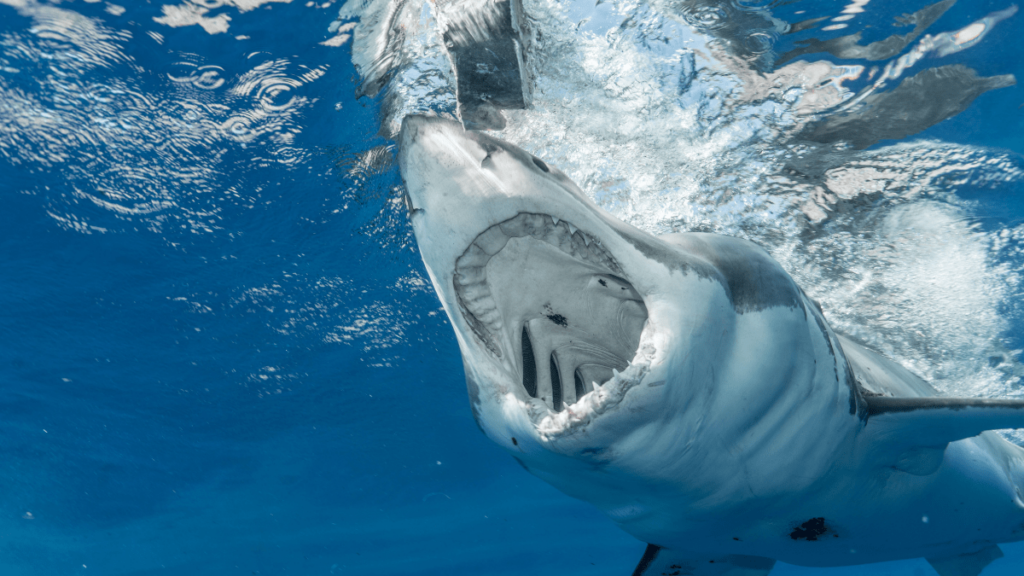
First off the bat, let’s lay out the basics regarding the great white shark. The shark is also known as the ‘white pointer’ or, simply, the ‘white shark’.
They are a type of mackerel shark, which is a family of large, fast-moving sharks that also includes the mako shark, the salmon shark, and the porbeagle shark.
Great whites are, as sharks go, extremely large. Males measure 3.4-4.0 meters; females, meanwhile, grow larger and measure between 4.6 and 4.9 meters. The largest specimen ever recorded, however, reached a staggering 5.83 meters.
It is an apex predator and has no natural predators (beyond the odd rare orca attack). It is also the world’s largest macro predatory fish (a fish that preys upon other larger prey species).
The great white shark species is one of the world’s longest-living fish and are estimated to live for as long as 70 years or more. It’s also extremely fast; thanks to its torpedo-shaped bodies, it can reach speeds of up to 25km/h in short bursts.
The fearsome reputation of great white sharks, while overstated, is at least a little earned; it’s responsible for more attacks on human beings than any other type of shark. These great white shark attacks are extremely rare, however, there are fewer than ten attacks a year recorded.
Where Do Great White Sharks Live Underwater?
Great white shark distribution has a surprisingly large range – they can be found in almost all coastal waters the world over.
For example, a great white shark can be found as far north as the waters off the coast of the south of France in Europe, and this shark species is found off every southernmost coast in the world.
Great white sharks are particularly dense in the waters off the coasts of California, South Africa, Chile, and Oceania. They can also be found (though rarely sighted) in the Mediterranean Sea.
What Are The Common Feeding Areas Of Great White Sharks?
Though great whites can be found almost anywhere worldwide, they are found most consistently in areas that contain large seal populations. As such, you’re more likely to see great whites in California, Guadalupe Island (near Mexico), Southern Australia, and South Africa.
What Marine Mammals and Reptiles Do Great White Sharks Commonly Eat?

As mentioned, great whites are ‘macro predatory’ fish. This means that they eat large animals, as opposed to other sharks that might eat smaller fish or organisms.
Great whites are not terribly fussy when it comes to their prey, and they will happily consume any of the following:
- Pinnipeds (seals, fur seals, and sea lions)
- Cetaceans (whales, dolphins, porpoises)
- Sea birds
- Sea otters
- Sea turtles
- Large fish (rays, tuna, other sharks)
Juvenile white sharks will limit their prey to fish only rather than larger marine mammals like sea lions, as their jaws have not yet developed the strength necessary to subdue cetaceans or pinnipeds. Older sharks, meanwhile, prefer marine mammals and will always prioritize them over other types of prey.
A great white’s diet is high in fat, which is an efficient and rich source of energy. It is, for this reason they exhibit a strong preference for pinnipeds (such as seals and sea lions), and this is why human beings aren’t anywhere near the top of the list when it comes to preferred prey – even the most rotund of individuals lack the sort of body fat percentage that great whites like.
How Do Great Whites Hunt Prey Like Sea Lions and Tuna?
Great white sharks are ambush predators and typically use the elements of shock and surprise in their attacks.
A great white shark will generally attack their prey from below (where the dark coloring of its upper body makes them hard to spot) with a single debilitating bite, then retreat and wait for its prey to bleed out before consuming them.
Their tactics vary depending on how dangerous their prey is, however. With larger animals, such as northern elephant seals, the shark will deliver a single large bite to the hindquarters, vastly reducing the seal’s mobility and causing massive blood loss. They will then wait for the animal to die before dragging it to the bottom to consume it.
”Great white sharks are ambush predators and typically use the elements of shock and surprise in their attacks.”
With smaller prey that is less able to fight back, however, the great white may simply drag it under the surface and wait for it to stop struggling before consuming it.
The great white typically hunts at dawn when visibility is much poorer. They have an initial hunt success rate of 55%, which drops off to 40% as the morning wears on. They then abandon any further hunting attempts.
Great Whites And Scavenging
Great whites may be apex predators, but they are also highly opportunistic. They frequently feed upon the carcasses of whales who’ve died at sea, as the blubber-rich carcasses can provide them with a large amount of energy. It’s estimated that this is the preferred method of feeding for larger (5+ meter) sharks, as they lack the maneuverability to hunt for seals or other, more mobile prey.
Are Sea Turtles Safe From Great White Sharks?
In a word: no. Sea turtles are seen as prey by great white sharks, and they will happily attack and consume any that they come across.
In fact, due to the size and strength of a great white shark, it is one of the few shark species that can bite clean through a sea turtle’s shell and rapidly kill it. Smaller sharks must instead attack the fins and/or head, which is much less efficient.
The great white shark is actually the largest (and most common) predator of the sea turtle – and so they are in great danger from these monsters of the deep.
However, sea turtles have also adapted to the threat and do have a small range of self-defense techniques. A prime example is the incident in the Sea of Japan that saw a great white shark choke to death on a sea turtle.
Anatomy Of A Great White Shark
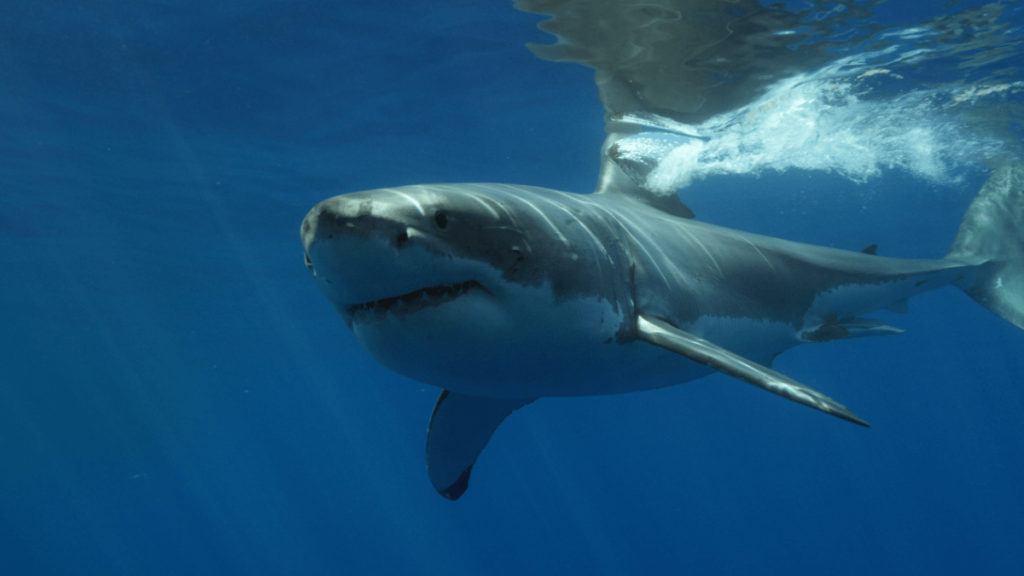
Great white sharks are sexually dimorphic, as we saw earlier. Females grow much larger than male great whites and are consequently much heavier.
The great white shark is characterized by a somewhat heavy, conical snout and tail fins that are of roughly equal size – a trait it shares with other mackerel sharks.
It famously has countershading, with a dark dorsal area and pale or white coloration on the underside.
This makes it easy for the shark to evade visual detection – looking from above, you’re unlikely to spot the dark dorsal area against the seabed or the water, and from below, the shark is backlit by surface light.
Great white sharks have larger eyes than almost all other sharks (a trait also shared by other mackerel sharks. In addition, their eyes are not actually black but are, in fact, a deep blue color.
Great whites have several rows of serrated teeth, with the backmost rows pushing forward to replace any that have been broken off at the front. It is common for them to lose teeth; when they have established a bite they will shake their head from side to side, causing massive damage to their prey. This violent action means their teeth are often dislodged or broken off.
In addition to their basic physical aspects, great whites have several interesting biological adaptations.
Ampullae Of Lorenzini
This specialized organ is unique to sharks and gives them an extra sense that most animals don’t have – chiefly, the ability to detect the electromagnetic fields generated by living creatures. This makes it extremely difficult to prey to hide from a great white, who can sense even heartbeats at close range.
The Rete Mirabile Regulates its Body Temperature
In order to regulate its body temperature and successfully hunt larger and more agile prey, the great white has evolved a network of veins and arteries called the rete mirabile (Latin for ‘wonderful net’).
This web of veins conserves heat and warms up arterial blood by pumping warmer venous blood, which has been close to the powerfully-working muscles through the arteries. As well as regulating the body temperature, this adaptation also allows the shark to conserve energy on long migratory swims with little food.
How Do Their Torpedo-Shaped Bodies Help Them?
The torpedo-shaped bodies of great whites have evolved as they have for two very specific reasons.
Firstly, it helps them to cruise efficiently for long periods of time – as mentioned, great whites often undergo lengthy migratory swims, and the shape of their bodies facilitates such swims without burning up too much energy.
Secondly, their body shape is also well-suited to sudden bursts of speed, such as those required to ambush seals on the surface. Due partially to the shape of their bodies and powerful tails, a great white shark can reach speeds of up to 25 miles per hour.
Is A Great White Shark The Largest Predatory Fish in the World?
Great whites are, indeed, the largest predatory fish on the planet, even though they’re not the largest sharks, despite popular belief.
Though whale sharks are the largest fish in the world (with the ability to outgrow even a humpback whale), these far larger sharks are not predatory like great white sharks; whale sharks are filter-feeders and eat such food as krill, plankton, and fish eggs.
Along with whale sharks, the only larger sharks than great whites are the basking shark and giant manta rays.
How Common Are Great White Shark Attacks On People?

The great white shark is responsible for more (recorded) shark attacks on humans than any other type of shark, with 333 confirmed cases on record (as of 2023). This has led to great white sharks getting a very bad reputation indeed.
That said, great white shark attacks are still extremely rare, all things considered. There are typically less than 10 recorded white pointer attacks annually, and fatal great white shark attacks are rarer still – there were 29 in total between 1990 and 2011.
To explore the list of five infamous great white shark attacks from over the years, you can read our shark attack guide here.
Why Do Great White Sharks Attack People?
There has been a great deal of speculation about why great white sharks might attack humans. The most common theory holds that the sharks are merely test-biting – that is to say, they are simply trying to figure out what something is by using their mouth, which is the only means they have to interact with objects around them.
This comes as little comfort to a person who’s been given a large bite from a great white shark, of course, as even a ‘test bite’ by such a powerful animal can be fatal to a human being. Nevertheless, such bites are not the result of active attempts to predate on human beings.
Another commonly posited reason is that great white attacks on humans are because they mistake human beings for one of their favorite prey – seals. This hypothesis is difficult to confirm or deny, but many postulate that the shark’s poor eyesight does not enable it to distinguish between seals and human beings, and so attacks are cases of mistaken identity.
Further, a human being strays far from the preferred prey type of the great white shark. Humans contain too much bone in comparison with their fat/muscle content, and this is unsuited to a great white’s digestive system.
It’s also been observed that great white sharks do not typically sustain attacks on humans, instead retreating after a single bite. It has been theorized that this is because they do not find the taste of human flesh palatable – or, at the very least, that they find it unfamiliar.
That said, it’s also been suggested that humans have an advantage in escaping from sharks where other animals do not. Human beings in the water who are attacked can frequently escape to a boat or the shore with the help of other humans.
This would thwart the great white’s preferred modus operandi against large mammalian prey, which is to bite once and then wait for them to bleed out.
Do Great White Sharks Attack Boats?
Yes, great whites have been known to attack boats – and sometimes even sink them. These types of attacks are, generally speaking, quite rare and are usually quickly broken off.
In some instances, great white sharks have bumped boats rather than biting them. This has sometimes resulted in crewmen being pitched overboard. No fatalities have ever been recorded as a result of any such incident, however.
Can Great White Sharks Be Kept In Captivity?
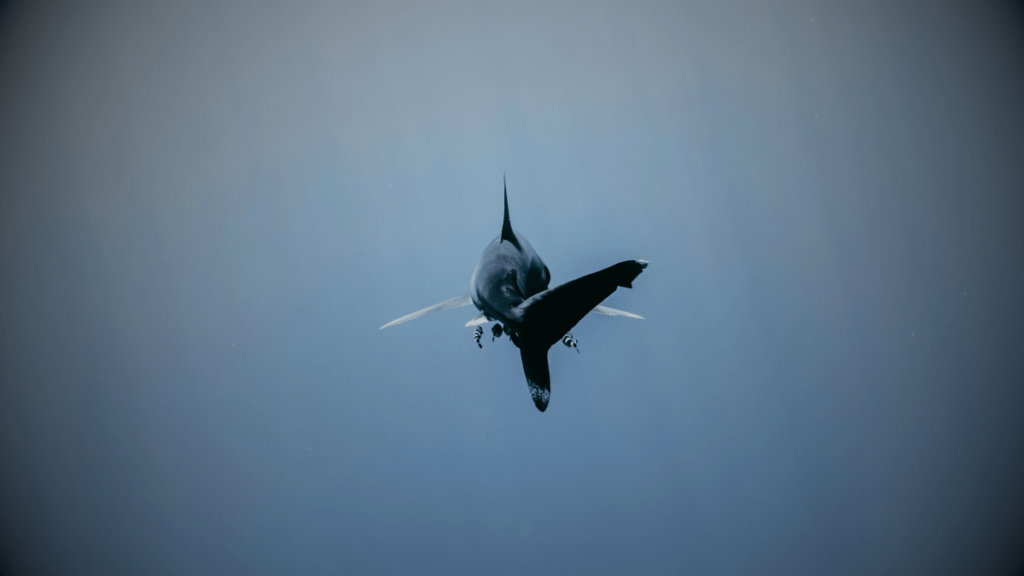
In essence, no. Great white sharks are too high risk and have too demanding of a diet to be kept in captivity, and all attempts to do so have not fared well, with these powerful predators exhibiting atypical behavior and often refusing to eat.
A handful of notable exceptions exist, all of which occurred at California’s Monterey Bay Aquarium.
The aquarium has been responsible for almost all successful instances of keeping a great white shark in captivity and is the only aquarium in the world that has successfully fed a captive great white.
The aquarium’s first attempt to house a great white in 1984 did not meet with much success; the shark, a young female, refused to eat and died after 11 days in captivity.
In 2003, they captured another young female great white shark and managed to hold it for five days before releasing her back into the Pacific. In that instance, they managed to induce the shark to feed.
In 2004, the aquarium enjoyed its biggest success yet with regard to keeping a great white shark in captivity. A juvenile female was captured and placed in a huge tank that contained 3.8 million liters of water. The aquarium kept the shark in the tank for a record-breaking 198 days before releasing her.
The Monterey Aquarium enjoyed further success with another five great white sharks before discontinuing the project. Some sharks were held in captivity for as long as half a year, whereas others were released after a few months. The aquarium has stated that they will not be displaying any more sharks in captivity, as they are too difficult to capture and feed, and the experience is too stressful on the shark.
In general, a long-term exhibition of great whites is considered unfeasible due to the above difficulties mentioned. The last attempt to hold a great white in captivity ended in failure when a male great white shark was held for three days at a Japanese aquarium before dying.
Can You Do Shark Dives With Great Whites?
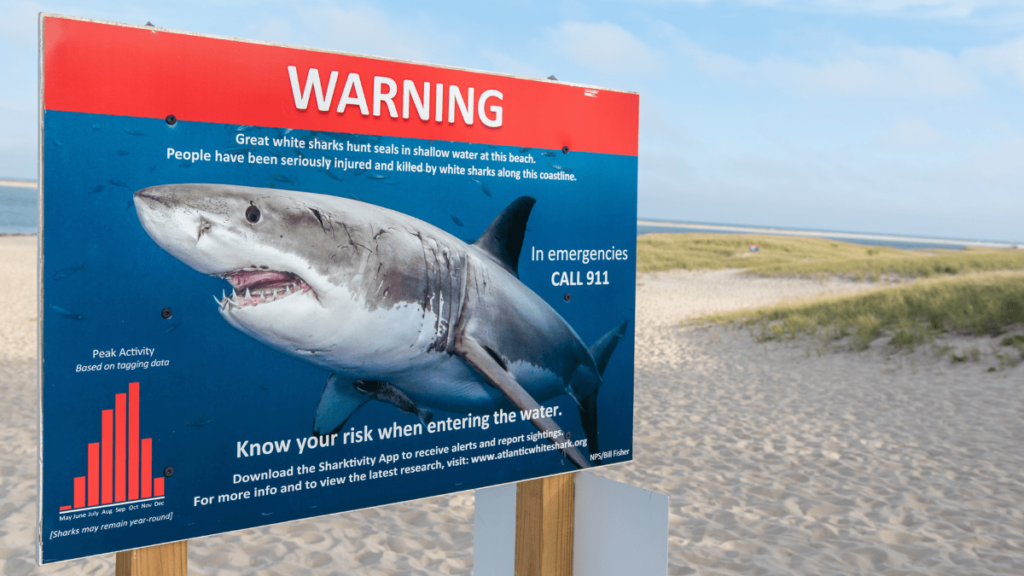
You certainly can dive with great white sharks, although the vast majority of these dives are, for obvious reasons, done in a cage.
There are a number of spots around the world’s oceans where great white sharks live and where people can increase their chances of seeing a great white in the wild.
These include the Neptune Islands just off the southern coast of Australia (the only place in Australia where cage diving is legal), Guadalupe Island off the coast of Baja California, and several points in the coastal waters of South Africa.
The practice of shark tourism across the world’s oceans has been criticized, particularly with regard to the commonly-used method of chumming in order to draw sharks in for tourists to view.
Critics and figures in the scientific community argue that chumming is high risk because it will affect shark feeding habits and cause them to associate the presence of human beings with food, a potentially extremely dangerous situation that may result in an increase in unprovoked shark attacks on humans.
”A shark cage tour operator has found that great white sharks are attracted to music by the Aussie band AC/DC.”
– Australian Geographic: Great white sharks attracted by AC/DC hits.
Many companies, therefore, take lengths not to use chum in order to attract sharks and have engaged in alternate methods to draw them in.
According to Australian Geographic, one unorthodox technique used in Australia has been the playing of music underwater in order to lure the sharks to the dive sites. Apparently, a few metalhead sharks have displayed a strong liking for AC/DC! Could they be any cooler?
Some famous shark experts, such as Ocean Ramsay or Juan Sharks, frequently dive with great whites in the world’s oceans without any protection at all. Check out this video below to see Ramsay in action; it’s incredible!
This is generally discouraged, and at present, there are no dive companies that will take customers on uncaged great white shark dives.
What Is The Conservation Status Of Great White Sharks?
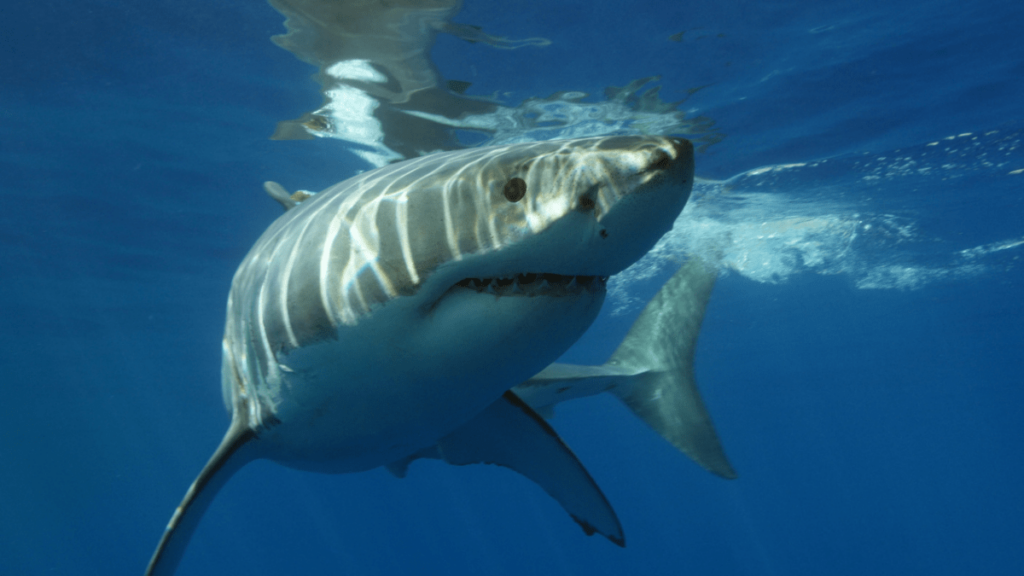
It is rather difficult to estimate the number of great white sharks across global waters. However, due to the relative rarity of sightings despite the wide great white shark distribution, the International Union for the Conservation of Nature classifies the conservation status of great white sharks as ‘vulnerable’.
One study put the estimated great white shark distribution at around 3500 globally, which would make the shark far more vulnerable than other shark species like the tiger shark (which shares a similar range).
However, another study done by a Florida university estimated that 2000 great whites can be found off the coast of California – around ten times the number estimated by the previous study.
One of the biggest risk factors for great white sharks is their own sexual maturity. It takes many years for a shark to reach sexual maturity, during which time they are not capable of reproducing. Thus, if they are killed (for whatever reason), then they are not able to contribute to future generations of great whites.
What Are The Biggest Man-Made Threats To Great Whites?
Great whites are typically not the object of commercial fishing, despite their flesh being considered valuable. This may be due to the relative difficulty of locating and capturing them. Nevertheless, some sharks are accidentally captured by fishermen not actively seeking them out, and they often die when accidentally captured in such a manner.
One of the largest threats to great whites, particularly in Australia, is so-called ‘culling’ programs. These programs use a variety of technologies to ensnare and kill sharks, with those found still living being shot. Shark nets used to protect beaches can also cause the sharks to die as they become entangled in the netting and cannot escape.
What Natural Threats Are There To The Great White Shark?
As apex predators, great whites are typically not threatened by other animals in the ocean. However, there have been isolated instances of orcas attacking, killing, and consuming the livers of great white sharks.
Though these attacks are rare, they demonstrate the superior size and strength of orcas in relation to great whites. The large cetaceans are able to immobilize and suspend the shark upside down, which induces tonic immobility. The sharks are then suffocated, and their livers (and only their livers) are eaten.
In areas where orcas have been observed to do this (most notably in South Africa and South Australia), great whites have ceded the area to the larger animals and sought prey elsewhere.
And That’s Almost Everything You Need to Know About The Biggest of the World’s Predatory Sharks!
Since sharks appeared for the first time in a library book I had as a child, I developed a lifelong fascination with them and have dedicated my life to spreading awareness and promoting the conservation of the white pointer.
This guide to the largest of the world’s predatory sharks is a long read indeed. But if you’ve made it this far, it’s clear your passion for great white sharks is strong!
I hope this extensive article has taught you everything you ever wanted to know about the great white shark. But wait, there’s more!
If you want to check out more fascinating facts about the world of the great white shark, then put on your diving gear and explore the surrounding water of our site here!

[…] Shark FAQs […]
[…] Shark FAQs […]
[…] Shark FAQs […]
[…] Shark FAQs […]
[…] Shark FAQs […]
[…] Shark FAQs […]
[…] Shark FAQs […]
[…] Shark FAQs […]
[…] Shark FAQs […]